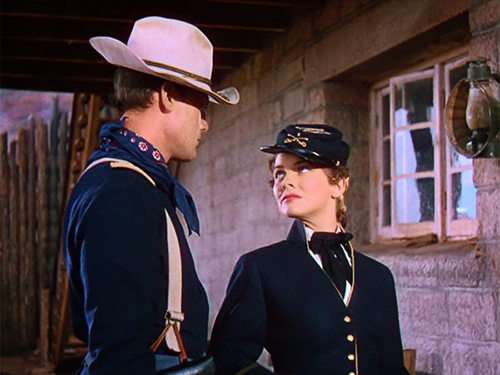
Captain Nathan Brittles, on the eve of retirement, takes out a last patrol to stop an impending massive Indian attack. Encumbered by women who must be evacuated, Brittles finds his mission imperiled.
EN
“A common and questionable idea has it that on television the close-up shot is king. If it was true, the man who one day shouted ‘I don’t want to see nose hair on a fifteen meter screen!’ would not stand a chance on the small screen. John Ford wasn’t very fond of close-ups, or of expository scenes, which amounts to the same thing. He shot very quickly and spent only 28 days directing She Wore a Yellow Ribbon (and not La charge héroïque, the ill-translated and stupid French title). It was in 1949; he was his own producer and did whatever he fancied. Forty one years later, the film ‘passes’ perfectly from the big to the small screen (on Channel 1). Elementary, you say? Not quite.
Gilles Deleuze one day reminded the youngsters of the FEMIS school of cinema that their work as filmmakers would consist in producing ‘blocks of duration-movement’. And if Ford’s blocks remain so perfect, it’s because they respect the most elementary of golden numbers: they only last the time it takes a practised eye to see everything they contain. The time to see all there is to see is the right duration and the right movement for an eye as disciplined in the art of looking as Ford’s horsemen are in the art of riding.
A principle so simple that it allowed Ford to complicate, refine and even convolute things while always giving a feeling of timeless classicism. It isn’t the action which determines duration, it’s the perception of an ideal spectator, of a scout who would see from afar all that there is to see (but nothing more). Rapid contemplation is the Ford paradox. It’s impossible to watch his movies with a lazy eye because we then no longer see anything (except stories of romantic soldiers). The eye must be sharp because in any image of a Ford’s film, there is likely to be a few tenths of a second of pure contemplation before the action starts. Someone goes out a wood shack or leaves the frame, and there are red clouds over a cemetery, a horse abandoned in the right hand corner of the image, the blue swarming of the cavalry, the distraught faces of two women: things to be seen at the very beginning of a shot, because they won’t be a ‘second time’ (too bad for the sluggish eyes).
Ford is one of the great artists of cinema. Not only because of the composition and the light of his shots but more deeply, because he shoots so quickly that he makes two movies at the same time: a movie to ward off time (stretching his stories out of fear of ending) and another to save the moment (the moment of the landscape, two seconds before the action). He enjoys the show ‘before’. So with Ford there is not point looking for characters who, in front of a beautiful landscape, would say ‘How beautiful!’ The character is not to whisper to the spectator what he should see. That would be immoral.”
Serge Daney1
- 1Serge Daney, “John Ford Forever,” sergedaney.blogspot.com, transl. Laurent Kretzschmar. The French version of this text was originally published in Liberation, 18 November 1988 and can be found in Serge Daney, Devant la recrudescence des vols de sacs à main, Aléas (http://www.aleas.fr/), 1997.
NL
“De identificatie van het western-landschap met de woestijn is in de cinema in grote mate te danken aan het werk van John Ford. Terwijl Anthony Mann the country van de individuele avonturier schetst, beeldhouwt Ford the land van een gemeenschap van pioniers. Terwijl de figuren van Mann doorheen het landschap vluchten, jagen of opgejaagd worden, hopen de personages van Ford het land te cultiveren. Bij Ford vormt de tegenstelling tussen wildernis en civilisatie de achtergrond waartegen mythe en geschiedenis worden verteld.”
Steven Jacobs1
- 1Steven Jacobs, “Et in Arizona ego. Sublimiteit en landschap in de westerns van Anthony Mann en John Ford,” De Witte Raaf, n°74 juli-augustus 1998.
FR
« Ford serait humaniste par désespoir, comme Mizoguchi. Lorsqu’on a ajouté tout à rien et que la somme reste égal à rien, il ne reste qu’à jouir et à jouer du mince privilège du ‘pithécantropus erectus’ : la station debout, la pose, la tenue. L’homme est ce qui persiste et qui signe, rien de plus. Plutôt le Sternberg dernière manière que Hawks, pourtant grand cinéaste et ami de toujours. Nous sommes loin, en effet de la coquetterie hawksienne d’un quant-à-soi si sobrement exhibé qu’il en devient tonitruant. Ford moins subtil, est plus raffiné. »
Serge Daney1
- 1Serge Daney, « John Ford, » Cahiers du cinéma, 1990, p. 62.

